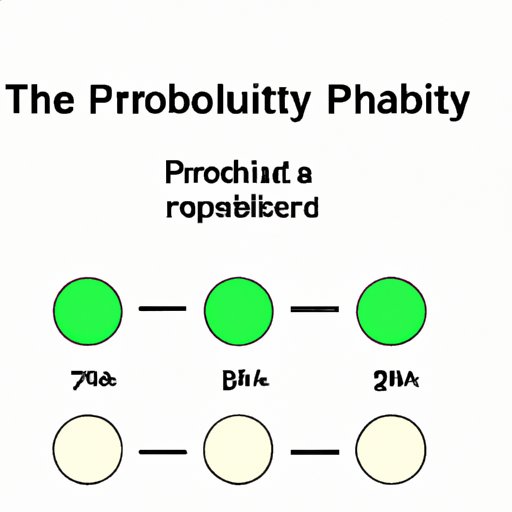Introduction
Probability is a concept that we encounter on a daily basis, from simple activities like predicting the weather to more complex decisions like investing in the stock market.
A. Definition of Probability
Probability is a measure of the likelihood or chance that a particular event or outcome will occur. It quantifies the possible outcomes of an experiment and assigns a number between 0 and 1 to each outcome, representing the probability of that outcome occurring.
B. Importance of Understanding Probability
Understanding probability is essential for decision making in various fields such as science, finance, and engineering. Moreover, knowledge of probability can help us make better predictions and estimate the risks involved in any scenario.
C. Overview of the Article’s Topics
This article will provide a comprehensive guide to finding probability. We will cover the basic concepts of probability, the math behind probability calculation, real-world examples, advanced techniques, and a step-by-step process for solving probability problems.
II. Understanding Probability: A Beginner’s Guide
A. What is Probability?
The probability of an event is computed as the number of favorable outcomes divided by the total number of possible outcomes.
B. Basic Concepts and Terms
The basic terms associated with probability include sample space, event, experiment, and outcome. Sample space refers to the set of all possible outcomes in an experiment. An event can be any subset of the sample space. Experiment refers to the process of performing an activity to observe its outcome, while an outcome is the result of an experiment.
C. Types of Probability
There are three types of probability: classical probability, empirical probability, and subjective probability. Classical probability relies on the assumption that all possible outcomes are equally likely and is used in scenarios like flipping a coin or rolling dice. Empirical probability is based on observation, and it is used in scenarios such as conducting surveys or experiments. Subjective probability is based on personal beliefs and is often used in fields such as economics and decision theory.
D. Probability vs. Possibility
Probability represents the likelihood of an event occurring, while possibility refers to whether an event can occur or not. Probability provides a more precise measure of the likelihood of an event compared to the term possibility.
III. The Math Behind Probability: Tips and Tricks for Calculation
A. Probability Rules and Formulas
The most basic formula for finding probability is P(E) = n(E) / n(S) where P(E) is the probability of event E occurring, n(E) is the number of favorable outcomes, and n(S) is the total number of outcomes. The addition rule, multiplication rule, and conditional probability rule are also used for probability calculation.
B. Combinatorics and Permutations
Combinatorics and permutations are important concepts in probability. Combinatorics deals with counting the number of ways to choose objects from a set, while permutations deal with counting the number of ways to arrange a set of objects.
C. Probability Distributions
Probability distributions are mathematical functions that describe the probabilities of different outcomes in a random event. Common probability distributions include the normal distribution, binomial distribution, and Poisson distribution.
IV. Finding Probability in Real-World Situations: Examples and Solutions
A. Probability in Everyday Life
Probability is used in everyday life scenarios like weather forecasting, transportation scheduling, and sports betting. We use probability to estimate the likelihood of events and make informed decisions.
B. Application of Probability in Fields such as Finance and Science
Probability plays a crucial role in finance and investment decisions, risk management, and scientific research. It helps in analyzing data, identifying trends, and predicting outcomes.
C. Case Studies and Examples
Case studies and examples help to understand the real-world application of probability. Examples include analyzing the probability of winning a lottery, the risk associated with investing in a stock market, and estimating the chance of a disease outbreak in a population.
V. Mastering Probability: Techniques for Precise Calculation
A. Common Mistakes and Pitfalls in Probability Calculation
Common mistakes in probability calculation include overlooking the sample space, calculating probability using wrong formulas, and confusing probability with possibility. It is essential to identify these errors to improve accuracy in probability calculation.
B. Strategies for Improving Accuracy and Precision
To improve accuracy and precision in probability calculation, it is essential to understand the underlying concepts and practice applying the formulas. Visualization techniques, like drawing diagrams, may help to understand complex problems better.
C. Advanced Probability Techniques for Complex Scenarios
Advanced probability techniques like Bayes theorem, Markov chain, and Monte Carlo simulation are used to model complex scenarios. These techniques are commonly used in fields like engineering, finance, and physics.
VI. Probability Made Simple: Steps for Finding Probability in Any Scenario
A. Step-by-Step Process for Solving Probability Problems
The following steps can be used for solving probability problems: identify the experiment and sample space, define the event, calculate the probability using the required formula, and interpret the results.
B. Examples and Walkthroughs
Examples and walkthroughs help to understand the process of solving probability problems. Sample problems include calculating the probability of multiple events, independent and dependent events, and conditional probability.
C. Practice Exercises for Readers
Practice exercises help readers to apply the learned concepts and improve their understanding of probability. Exercises include solving problems in combinatorics, probability distributions, and real-world scenarios.
VII. The Ultimate Guide for Finding Probability: From Basics to Advanced Methods
A. Review of the Article’s Topics
This article provided a comprehensive guide to finding probability, covering basic concepts, math behind probability calculation, real-world examples, advanced techniques, and the step-by-step process for solving probability problems.
B. Additional Resources for Further Learning
Additional resources like textbooks, online courses, and probability software are available for further learning and practice. These resources help to improve knowledge and skills in probability calculation.
C. Conclusion and Final Tips for Mastering Probability
Probability is a crucial concept for decision making in various fields. With practice and understanding of the fundamental concepts, anyone can master probability. Remember to identify common mistakes, apply the correct formulas, and practice regularly to improve accuracy.
